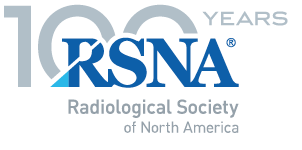Artists Draw on Unique Inspirations to Create Winning Entries in RSNA Image Contest
The RSNA 2015 Image Contest winners were awarded in four categories: Radiology Art, Most Unusual Case, Best Medical Image and Best Photo
Medical Images Transformed to Artwork
In creating her winning entry in the Best Medical Image category, Narine Wandrey, a second-year medical student at the University of Texas Health Science Center at San Antonio, focused on mineralocorticoid receptors and vasopressin synthesizing neurons in the hypothalamus of a rat. Artists in this category were asked to submit a high-quality, high-detail image depicting how medical imaging is used in the diagnosis or treatment of patients.
“Vasopressin and mineralocorticoid receptors have been implicated in the development of hypertension,” Wandrey said. “The pathophysiology behind the development of salt-sensitive hypertension is poorly understood, so any finding such as the location of neurons believed to contribute to hypertension is unusual and important for scientists.”
Using software, Wandrey compiled images taken from confocal microscopy to create a colorful image that mimics a modern art painting.
“I love neuroscience,” Wandrey said. “The brain remains one of the most elusive organs in the body and capturing any aspect of it through art is beautiful.”
The Most Unusual Case was submitted by Asad Jalil, M.D., a resident in nuclear medicine at Dr. Ziauddin Hospital in Pakistan, where a metastatic work-up on a patient revealed thoracic renal ectopia—a renal anomaly that occurs in roughly one out of every 13,000 people.
“It was the first time I have seen a kidney in the thoracic region,” Dr. Jalil said. In this category, artists were asked to submit an image depicting a rare disease or condition or to illustrate an extremely atypical finding.
Another phenomenon known as the Northern Lights was the subject of this year’s Best Photo taken by Vishal Kalia, M.D., a radiologist at SAk Akureyri Hospital in Iceland. To capture the ethereal green light show provided by the Aurora Borealis, Dr. Kalia and his wife traveled to the southern part of the country last winter.
“You need three to four conditions including total darkness and cold temperatures for the lights to show up,” said Dr. Kalia, who explained that the large black spheres in the foreground of his winning picture were haystacks covered in plastic. The Best Photo category was open to all types of images.
Re-imagining Medical Images
To create her winning Radiology Art image, radiology resident Katia Kaplan- List, M.D., from Rochester General Hospital, in Rochester, New York, drew inspiration from one of the most wellknown images in modern culture: Vincent Van Gogh’s Starry Night.
To take her mind off work, Dr. Kaplan-List paints and uses Photoshop to create art.
“Art is a creative outlet that allows me to look at images from a different perspective,” she said. “The human body is so complicated and fragile. . . I find it’s a really fruitful field for my imagination.”
It took just a few days for Dr. Kaplan-List to create “Eyes Like Stars,” transforming MR and CT images of eye globes into stars and the moon, slices of brain MR images into the hills in the foreground, and ultrasound images of pseudoaneurysms into swirling yinyang clouds. Artists in this category were asked to submit an image of a unique non-human element, with or without creative enhancements, taken with medical imaging equipment.
“The cypress tree is a composite of two images of the small bowel from a paracentesis,” she said.
Her winning image has gained Dr. Kaplan-List the admiration of her colleagues at Rochester General Hospital, who have asked for copies of her artwork and plan on framing and hanging a poster of “Eyes Like Stars” in the department. She’s also been able to connect with some of the other artists who submitted work to the RSNA Image Contest, including radiologists in Russia.

Web Extras
- All images submitted for the contest can be viewed at RSNA.org/centennial